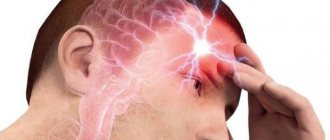Today, the diagnosis of vegetative-vascular dystonia (VSD) is being made less and less often to patients, but not because humanity has been able to completely defeat this disease, but because this formulation is outdated. Vegetative-vascular dystonia means dysfunction of the autonomic nervous system, which is not an independent disease, but is only a consequence of pathological changes in the body.
In the latest edition of ICD-10 there is no such disease as VSD. The disorders characteristic of it are called by the more modern and precise term “somatoform autonomic dysfunction of the nervous system.” But for simplicity of presentation and understanding, we will further use the more familiar concept of VSD.
What is VSD
The autonomic nervous system, also called the autonomic nervous system, is part of the nervous system of the human body. It is responsible for controlling the activity of internal organs, metabolic processes occurring in the body, the functioning of blood and lymphatic vessels, as well as the activity of the endocrine glands. Thus, the autonomic nervous system plays an important role in maintaining homeostasis (constancy of the internal environment) and adaptation to changing environmental conditions.
The autonomic nervous system is responsible for the innervation of the entire body, organs and tissues. Moreover, its work is in no way subordinate to the will of a person, but is controlled independently of desires by the cerebral cortex. That is, a person cannot voluntarily stop the heart or influence the speed of intestinal peristalsis.
Autonomic nerve centers are also located in the brain stem, hypothalamus and spinal cord. Therefore, any disturbances in these organs are directly reflected in the quality of functioning of the autonomic nervous system, and can lead to the development of autonomic disorders.
Thus, all vital processes of the body are under the control of the autonomic nervous system, namely:
- heart rate;
- blood pressure level;
- thermoregulation;
- activity of salivary, sweat, endocrine glands;
- frequency and depth of breathing;
- digestion of food and intestinal motility;
- the condition of the smooth muscles of internal organs and the walls of blood vessels;
- processes of growth and reproduction;
- metabolic processes;
- urination, etc.
Anatomically and functionally, the autonomic nervous system is divided into 3 sections:
- Sympathetic - responsible for metabolism, energy consumption and mobilization of forces for active activity. Its sphere of influence includes heart function and blood pressure levels. Therefore, the sympathetic department allows the human body to prepare as much as possible for fight or active work.
- Parasympathetic - regulates the functioning of organs mainly during sleep and passive rest, and is responsible for restoring spent energy reserves. It is responsible for reducing heart rate, blood pressure and increasing peristalsis, which makes it possible to replenish energy reserves from food received.
- Metasympathetic - ensures communication between internal organs and the preservation of local autonomic reflexes.
All parts of the autonomic nervous system are in a certain relationship with each other, which ensures proper regulation of the body’s functioning. At the same time, the most important organs from the point of view of life support have double innervation with the opposite effect. But when the slightest deviation from the norm occurs, under the influence of stress, the balance between the sympathetic and parasympathetic departments is disrupted, which leads to the predominance of one of them over the other. The result of this is the development of vegetative-vascular dystonia.
Vegetative-vascular dystonia is a syndrome that combines various disorders of autonomic functions that are the result of impaired neurogenic regulation. This occurs when the balance between the activity of the sympathetic and parasympathetic parts of the autonomic nervous system is disturbed, which can be due to the action of a huge variety of the most disparate causes.
Thus, VSD is a multifactorial disorder that can be regarded as one of the symptoms of an existing neurological or somatic disease and consists of changes in the functioning of internal organs. Sometimes the root cause of the development of vegetative-vascular dystonia cannot be established.
Vegetative-vascular dystonia is often also called cardioneurosis, dysvegetosis, neurasthenia and some other terms.
Causes of vegetative-vascular dystonia
VSD can develop against the backdrop of a huge number of diverse factors. Among them are especially distinguished:
- psychological – severe or constant stress, depressive states;
- physical – severe physical fatigue, exposure to vibration, high temperatures, sunstroke;
- chemical – addiction to alcohol, nicotine, narcotic substances, taking a number of medications, in particular those containing ephedrine, caffeine, bronchodilators;
- changes in hormonal levels - adolescence, pregnancy and lactation, menopause, use of hormonal contraceptives, especially with frequent periods of withdrawal;
- infectious – acute and chronic diseases of the respiratory system, kidneys, brain;
- neurological disorders - Parkinson's disease, traumatic brain injury;
- endocrine diseases – diabetes mellitus, thyrotoxicosis;
- pathologies of the cardiovascular system - arterial hypertension, coronary artery disease.
It is believed that the main cause of the development of VSD is stress.
But not all people who have even several of the listed diseases develop vegetative-vascular dystonia. Women suffer from it 2 times more often than men, and almost half of all cases of VSD diagnosis occur in young girls who have not yet turned 25 years old. And only 33% of women with vegetative-vascular dystonia are over 25 years old.
Heredity plays a significant role in assessing the risk of VSD. Very often it first appears in childhood or adolescence. As one gets older, the disorder can be compensated and the attacks disappear. But the impact of negative factors can reverse the situation and again provoke the occurrence of vegetative-vascular dystonia.
The impetus for its development can be:
- psychological characteristics of the individual, especially suspiciousness and a tendency towards hypochondria;
- unfavorable socio-economic, environmental conditions (lack of sunlight, sedentary lifestyle, lack of funds, lack of nutritional culture, consumption of cheap, low-quality products, etc.);
- intrauterine pathologies - infections, hypoxia, fetoplacental insufficiency, rhesus conflict, etc.
Sometimes VSD is a transient reaction to any strong emotional shocks or emergency situations.
What is the manifestation of vegetative dystonia syndrome?
Autonomic dystonia syndrome is divided into three main types:
Vegetative-vascular-trophic syndrome is based on autonomic disorders caused by lesions of mixed nerves, roots and plexuses responsible for supplying impulses to the extremities.
The syndrome of progressive autonomic failure is expressed by peripheral and cerebral disorders in combination with peripheral segmental disorders.
Psychovegetative syndrome is manifested by paroxysmal disorders caused by dysfunction of various brain systems.
Symptoms of vegetative-vascular dystonia
Thus, it is already clear that vegetative-vascular dystonia can manifest itself in radically different ways. This concept “protects” various symptoms that arise in response to disturbances in the functioning of the autonomic nervous system.
In most cases, VSD occurs latently. But under the influence of overload or other unfavorable factors, an attack develops. Often they arise suddenly and unsettle a person. They are most difficult for older people, since they usually already have a number of other diseases, which aggravates the situation.
Often there are signs of other diseases that are not directly related to the autonomic nervous system or brain. But if manifestations of disturbances in the functioning of the cardiovascular system are observed, the neurologist has good reason to assume the presence of VSD.
The most common complaints of patients who are subsequently diagnosed with vegetative-vascular dystonia are:
- headaches of varying degrees of intensity and duration, migraines;
- attacks of dizziness;
- increased sweating;
- increased heart rate;
- severe weakness, increased fatigue;
- fluctuations in body temperature;
- noise in ears;
- darkening of the eyes, sometimes followed by fainting;
- constant drowsiness;
- increased anxiety, panic attacks;
- sudden mood swings;
- obsessive syndromes, hypochondria.
A panic attack is a strong fear of imminent death that completely grips the patient. The attack begins with the onset of anxiety, which gradually increases and turns into genuine horror. This is explained by the fact that the body sends signals of danger, but does not see options for exiting the situation. The attack lasts on average 10–15 minutes, after which the patient’s well-being gradually returns to normal.
Panic attacks with VSD
VSD and panic attacks are considered completely different conditions. Many patients confuse these diseases because they differ in other similar symptoms. During an attack of dystonia and at the time of a panic attack, a release of adrenaline, norepinephrine, and acetylcholine occurs (observed in the sympathetic form). Therefore, many experts diagnose people with a tendency to panic attacks as VSD.
This conclusion is considered erroneous. To eliminate vegetative-vascular dystonia, it is necessary to take medications, and the treatment of panic attacks is carried out using psychotherapy methods.
It is easy to confuse VSD and a panic attack. Experts in the post-Soviet space practically do not diagnose panic attacks. They are treating the disease. To eliminate the symptoms of panic attacks, you do not need to take medications.
To stabilize blood pressure parameters, to combat headaches and pathologies in the heart area, the help of a psychotherapist is needed. This deviation is a neurosis. Vegetative vascular dystonia is considered a deviation of the autonomic nervous system. This condition requires the use of medications.
Types of VSD
The nature of the manifestation of signs of VSD directly depends on the condition of the blood vessels. Based on this, the following types of vegetative-vascular dystonia are distinguished:
- hypertensive;
- hypotonic;
- mixed;
- cardiac;
- vagotonic.
But symptoms are extremely rarely present all the time. Most often they are in the nature of attacks. Not all of the signs characteristic of a particular type of vegetative-vascular dystonia always appear. Moreover, this is rare. Typically, patients complain of 2-3 disorders, the presence of which, in combination with the results of the examinations, makes it possible to determine the specific type of vegetative-vascular dystonia.
Based on how VSD occurs, there are 3 degrees of severity of the disorder:
- mild – patients fully retain their ability to work, symptoms of VSD do not cause them significant discomfort, and there are no vegetative crises;
- moderately severe – periods periodically occur during which a person loses ability to work due to exacerbation of vegetative-vascular dystonia and the development of a vegetative crisis;
- severe - a long, persistent course of VSD with frequent periods of exacerbation and crises, which leads to a significant decrease in performance.
Hypertensive type
Patients experience pronounced vascular tone, as well as a persistent increase in blood pressure. Their main complaints focus on the occurrence of:
- rapid heartbeat;
- hot flashes;
- headaches;
- constant fatigue;
- nausea, vomiting, attacks of which are not associated with eating;
- decrease in appetite up to its complete loss;
- sweating (during an attack there is severe sweating of the palms);
- causeless but strong fear;
- flickering “flies” before the eyes.
Hypotonic type
Characterized by low blood vessel tone and low blood pressure. Therefore, patients are often annoyed by:
- episodes of darkening of the eyes;
- a sharp decrease in blood pressure;
- severe weakness;
- loss of consciousness;
- pale skin;
- nausea, heartburn;
- changes in bowel habits (diarrhea or constipation);
- inability to take a full breath.
It can be noted that in patients with VSD of the hypotonic type, the palms and feet are constantly cold.
Mixed type
With this variant of VSD, variability in vascular tone is observed, so blood pressure can fluctuate within a fairly wide range. It can rise sharply to high levels and then suddenly drop to extreme levels.
In such cases, there is a change in the symptoms of VSD, which occurs according to the hypertensive type, with manifestations of VSD of the hypotonic type. This significantly affects the lives of patients, as attacks of weakness, profuse sweating and fainting states are replaced by hot flashes, tachycardia and headaches.
During an attack, there is often a fear of imminent death and the inability to take a full breath, which further aggravates the situation. Pain in the heart area may be present.
Cardiac type
This type of VSD is diagnosed when aching, throbbing pain occurs in the heart area, which does not have a significant effect on a person’s general well-being. They may be accompanied by arrhythmia and profuse sweating, but the examinations carried out do not reveal heart pathologies.
Vagotonic type
For this type of vegetative-vascular dystonia, the occurrence of breathing disorders is typical. Patients often complain of the inability to take a full breath and a feeling of tightness in the chest. In this case, there may be a tendency to lower blood pressure and slow heartbeat. But with the vagotonic type of VSD, there is an increase in salivation and changes in the functioning of the organs of the digestive system.
Complications
Vegetative-vascular dystonia sometimes leads to the most dangerous exacerbations and complications. The development of vegetative crises is possible, observed in half of the cases. Depending on the part of the autonomic system that is affected, crises can be vagoinsular, sympathoadrenal, or mixed.
A sympathoadrenal crisis is called a panic attack. This condition is accompanied by a sharp release of adrenaline in the blood. The abnormal process occurs under the influence of the autonomic system. As the disorder develops, the patient experiences a sharp headache and increased heart rate. Symptoms of cardialgia may appear. The face turns red or pale.
Vegetative-vascular dystonia is accompanied by the appearance of symptoms of arterial hypertension, increased heart rate, increased temperature to subfebrile levels, chills, loss of sensation in the limbs, a feeling of severe anxiety and fear, which is taken into account in the diagnosis. The crisis ends as suddenly as it begins and lasts for a short period. After its completion, asthenia develops, polyuria occurs, accompanied by the release of urine of low specific gravity.
Vagoinsular crisis is characterized by criteria opposite to sympathetic effects. In this state, there is a release of insulin in the blood, the glucose level drops sharply, and the activity of the digestive organs increases.
A person’s heart stops, arrhythmia develops, dizziness develops, breathing becomes impaired, a feeling of lack of air appears, the pulse slows down, and blood pressure drops. Symptoms of increased sweating, redness of the skin, general weakness, and darkening of the eyes appear.
The crisis is characterized by increased intestinal motility, causing flatulence, diarrhea, and rumbling in the abdomen. After the end of the attack, pronounced post-crisis asthenia is observed. In most cases, mixed types of crises appear, both parts of the autonomic system are activated.
How does an attack go?
During an attack of VSD, a sympathoadrenal crisis is observed, as a large amount of adrenaline is suddenly released into the blood. Then it starts suddenly. At the same time, you begin to feel your heartbeat, your blood pressure and body temperature rise. In this case, the skin may turn pale and chills may occur. This is accompanied by the appearance of strong fear for one’s own life. This condition lasts on average 20–30 minutes, but can last 2–3 hours, after which the condition gradually improves.
Attacks may occur several times a week or several times a day.
After the attack ends, the patient feels a strong urge to urinate, during which a large volume of light-colored urine is released. Fear is replaced by severe weakness, as there is often a sharp decrease in blood pressure. In some cases, this is accompanied by tremors in the legs, up to the inability to walk normally.
After an attack, people tend to become anxious and fear new episodes. Therefore, depression often occurs, which makes the situation even worse. Also, patients with VSD may tend to refuse to communicate with other people because they are ashamed of their illness and its manifestations. But at the same time, they are also afraid of not receiving much-needed medical care at the right time, which also does not help improve the situation.
Also, an attack of VSD can occur with a vagoinsular crisis. In this case, the attack begins with the appearance of pre-syncope symptoms:
- noise in ears;
- darkening of the eyes;
- sudden weakness;
- a feeling of unreality of what is happening.
These phenomena are observed for a very short period of time, and are replaced by loss of consciousness.
During a vagoinsular crisis, severe abdominal pain and a powerful, urgent desire to empty the intestines may occur. During an attack, accelerated intestinal motility, decreased blood pressure, slowed heart rate and severe sweating are observed. Patients usually complain of cold sweat with a pronounced feeling of heat. They are often overcome by indescribable melancholy and strong fear appears.
Very rarely, an attack of VSD occurs of a mixed type, in which symptoms typical of a vagoinsular and sympathoadrenal crisis are observed. Most often in such cases it is observed:
- shortness of breath, up to a feeling of suffocation;
- chest pain;
- increased heart rate;
- severe dizziness;
- unsteady gait;
- very strong fear of death;
- a feeling of unreality of what is happening.
Diagnostics
To diagnose and prescribe treatment for VSD, you must consult a neurologist. Before the consultation, it is best to make a detailed list of complaints. This will help the specialist not only detect VSD, but also suggest what caused its development. The doctor will definitely conduct a thorough survey, during which he will also find out the presence and nature of the prerequisites for the development of vegetative-vascular dystonia.
Then the neurologist proceeds to the examination. The doctor assesses the condition of the skin, measures the pulse, blood pressure, sometimes using an orthostatic test (2 measurements are taken: one in a lying position, the second after taking up a vertical position), listens to the lungs and heart. To assess the activity of the sympathetic and parasympathetic autonomic nervous system, he may pass the end of the hammer handle over the skin.
After completing the examination and assuming the presence of VSD, the neurologist must prescribe a set of studies that will help detect or confirm existing assumptions about the causes of the development of the disorder. For this purpose, patients are prescribed:
- UAC and OAM;
- blood sugar test;
- blood test for TSH, T3 and T4 (thyroid hormones);
- biochemical blood test to determine the concentration of potassium, cholesterol, creatinine, urea and other compounds;
- ECG;
- fluorography of the chest organs;
- rheoencephalography;
- MRI;
- Ultrasound scanning of neck vessels;
- EEG.
In our clinic, you can also learn in more detail about the composition of your body and the state of the vascular system, which is involved in the blood supply to internal organs, skeletal muscles, and the brain. Our experienced doctors will explain the data obtained to you in detail. Bioimpendansometry calculates the ratio of fat, muscle, bone and skeletal mass, total fluid in the body, and basal metabolic rate. The intensity of recommended physical activity depends on the state of muscle mass. Metabolic processes, in turn, affect the body's ability to recover. Based on the indicators of active cell mass, one can judge the level of physical activity and nutritional balance. This simple and quick test helps us identify disturbances in the endocrine system and take the necessary measures. In addition, it is also very important for us to know the condition of blood vessels for the prevention of diseases such as heart attacks, hypertension, heart failure, diabetes and much more. Angioscan allows you to determine such important indicators as the biological age of blood vessels, their stiffness, stress index (which indicates heart rate), and blood oxygen saturation. Such screening will be useful for men and women over 30, athletes, those undergoing long-term and severe treatment, as well as everyone who monitors their health.
Treatment of vegetative-vascular dystonia
Treatment of VSD is always selected strictly individually. In this case, the neurologist must take into account a lot of factors and formulate the optimal tactics. Not only the type of vegetative-vascular dystonia, the severity and frequency of attacks, the patient’s age, but also the presence of concomitant diseases and their characteristics are taken into account.
When prescribing treatment for patients with VSD, neurologists pursue two goals: eliminating the symptoms of vegetative-vascular dystonia and influencing the cause of the development of dysfunction of the autonomic nervous system. The second task is of particular importance, since sometimes it is not possible to find the true cause of VSD. But the patient’s quality of life in the future primarily depends on this, since by eliminating the cause of VSD, the cause itself will also be eliminated. Therefore, treatment of vegetative-vascular dystonia is often carried out not only by a neurologist, but also by other specialized specialists, in particular, a cardiologist.
Also, treatment of vegetative-vascular dystonia involves influencing the psycho-emotional state of patients, since stress and prolonged nervous tension definitely do not improve their condition.
Thus, the treatment of vegetative-vascular dystonia is always complex. It includes:
- drug therapy;
- lifestyle correction;
- psychotherapy;
- Spa treatment.
To combat the causes of VSD, manual therapy is often used. This is due to the fact that a competent effect on the spine can improve the performance of almost every organ of the human body. After all, it is in the spinal cord that the autonomic centers are located, which suffer greatly in the presence of spinal pathologies.
Therefore, the elimination of scoliosis, protrusions, herniated intervertebral discs, spondylosis and other disorders necessarily leads to a significant improvement in the condition of patients, and when treated in the early stages, a complete elimination of the causes of the development of VSD.
One of the most effective methods of manual therapy is the original Gritsenko method. With its help, you can restore the normal position of each vertebra and thereby completely normalize the functioning of the spinal cord. As a result, blood circulation also improves, back and chest pain, breathing problems, and a host of other disorders go away. An additional “bonus” is an increase in the body’s adaptive capabilities and a slowdown in the natural aging process.
When manual therapy is performed correctly, improvements are observed after the first sessions. But to consolidate the results and eliminate the causes of vegetative-vascular dystonia, you need to undergo a course of manual therapy. Moreover, sessions can be combined with work, study, business trips and other activities.
Drug therapy
Treatment of VSD involves the use of a whole range of medications, the list of which, as well as the dosage, is determined by the neurologist on an individual basis. Thus, drug therapy for vegetative-vascular dystonia may include:
- Antidepressants help eliminate excessive anxiety, increased irritability and help overcome depression, psycho-emotional stress, and apathy. Often, while taking antidepressants, there is a decrease in heart pain and muscle pain, even in cases where they previously could not be relieved by other means.
- Tranquilizers - used to reduce the risk of panic attacks, eliminate causeless fears and relieve increased anxiety.
- Sedatives - initially preference is given to herbal remedies, but if they do not have the desired effect, they are replaced with “heavy artillery”. Herbal remedies act gently; in the absence of allergies, they do not have a negative effect on the body, but have a beneficial effect on the nervous system.
- Nootropics are designed to activate blood circulation in the vessels of the brain, remove the negative effects of hypoxia (oxygen deficiency) and increase the body’s ability to resist stress.
- Adrenergic blockers are prescribed when problems with the heart are detected.
- Diuretics - used in the presence of headaches, attacks of dizziness that occur against the background of increased intracranial pressure or arterial hypertension. They help remove excess fluid from the body, but lead to a decrease in sodium levels, and some potassium levels. This can negatively affect the functioning of the heart, so diuretics are often combined with drugs that replenish the deficiency of these ions.
- Vitamin preparations containing B vitamins improve the conductivity of nerve impulses and generally have a positive effect on the state of the nervous system as a whole.
- Metabolic drugs - designed to increase control over glucose levels, have microcircular, antihypoxic properties.
Lifestyle correction
In order to improve the functioning of the autonomic nervous system, patients with VSD are recommended to reconsider their lifestyle and habits. Thus, neurologists recommend to all patients:
- Organize the correct work and rest schedule. During the workday, it is important to take breaks, leave your chair and go for a walk to improve blood flow in the body and give your head a chance to rest.
- Get enough sleep. It is recommended to sleep at least 8 hours every day.
- Walk outdoors every day. It's worth walking for about an hour. This is enough to improve the functioning of the entire body.
- Make moderate physical activity an integral part of your life. Fanatical exercise with VSD will be detrimental, but half an hour of jogging, aerobics, and swimming will be very helpful.
- Eat properly. Patients are advised to avoid foods with a high content of trans fats, which contribute to the formation of atherosclerotic plaques and also increase nervous excitability. But a strict diet for VSD is not indicated, since strict restrictions can negatively affect the psycho-emotional state of the patient, which will aggravate the course of vegetative-vascular dystonia.
Since the topic of nutrition in VSD raises many questions, it requires a more detailed consideration. With such a diagnosis, the diet should be built in accordance with the following principles:
- enriching the diet with foods that are sources of potassium and magnesium and have a positive effect on the functioning of the cardiovascular system, in particular blood pressure levels;
- normalization of water-salt balance by drinking 1.5 liters of water per day, in addition to tea, juices and other drinks;
- enjoying food;
- bringing the diet as close as possible to the requirements of a healthy diet.
The nature of the diet may vary depending on the type of vegetative-vascular dystonia. So, in case of hypertensive form, it is important to exclude foods containing large amounts of “hidden” salt. For this purpose, it is recommended to refrain from eating fast food, canned food, marinades, semi-finished products, etc. Instead, patients are asked to include soups with vegetable or weak meat or fish broth in their daily menu. It is also recommended to replace traditional wheat or rye bread with products made from whole grain flour or with bran.
With hypotonic VSD, when creating a menu, you should pay special attention to vegetables and fruits that contain increased amounts of well-absorbed vitamin C and β-carotene, as well as foods that increase blood pressure. Thus, with this form of dysfunction of the autonomic nervous system, it is worth introducing into the daily diet:
- citrus fruits, bananas, bell peppers, pineapples, pomegranate;
- any nuts, buckwheat, liver, brains;
- cheeses;
- herring;
- dark chocolate, cocoa, coffee.
With hypotonic VSD, it is not prohibited to eat white bread, potatoes and even sweets.
If a patient is diagnosed with a cardiac form of the disease, he is recommended to bring foods that are a source of magnesium and potassium to his table. This will have a positive effect on the functioning of the heart muscle and reduce the risk of developing dangerous complications. Therefore, they should pay attention to:
- oatmeal, buckwheat;
- legumes;
- onions, eggplants;
- apricots, peaches, grapes, including in the form of dried fruits;
- natural juices, compotes, jelly;
- dairy products;
- chicken eggs;
- lean varieties of fish and meat.
Psychotherapy
With vegetative-vascular dystonia, it is important not to close yourself off from the problem, but to solve it. Therefore, competent psychotherapy plays a significant role in the treatment of VSD. Psychotherapy helps you understand yourself better, become calmer and more confident.
Spa treatment
An annual holiday in a sanatorium outside the period of exacerbation of vegetative-vascular dystonia has a positive effect on the physical and psycho-emotional state of people, which helps to prolong remission. But with VSD, long trips abroad will not be the best idea. It would be more correct to choose a balneological resort in the climatic zone in which he permanently lives, since a sharp change in climate can negatively affect a person’s condition and provoke a new exacerbation of VSD.
Consequences of VSD
Despite the fact that vegetative-vascular dystonia manifests itself quite severely, it has a positive prognosis. Of course, the risk of developing negative consequences is directly influenced by strict adherence to medical recommendations, especially regarding adherence to a daily routine, giving up bad habits and taking prescribed medications.
With a careful approach to the treatment of VSD, the risk of developing undesirable consequences is minimal. But if the problem is ignored, patients have a high chance of later encountering:
- tachycardia;
- hypertension that cannot be treated with traditional drugs to lower blood pressure;
- cardiomyopathy;
- diabetes mellitus type 2;
- urolithiasis and cholelithiasis;
- stroke, myocardial infarction.
VSD negatively affects the immune system. Therefore, patients with this diagnosis are much more likely than others to suffer from respiratory infections. In this case, a vicious circle is formed, since in acute respiratory infections attacks are observed more often.
5 2 votes
Article rating
Prevention
In order to reduce the risk of developing symptoms of VSD, the following preventive recommendations must be followed:
- to live an active lifestyle;
- avoid psycho-emotional stress;
- do not abuse alcohol or caffeine-containing drinks;
- stop smoking;
- adhere to a rational and balanced diet.
These medical advice will help minimize the possibility of vegetative-vascular dystonia.
When the first signs of pathology appear, you must contact a doctor for a medical examination. Doctors at the Yusupov Hospital in Moscow will perform a full course of diagnostics necessary to identify vegetative-vascular dystonia. They will prescribe treatment that will relieve the unpleasant symptoms of the disease.
You can ask questions or make an appointment with a doctor by phone.
Make an appointment










